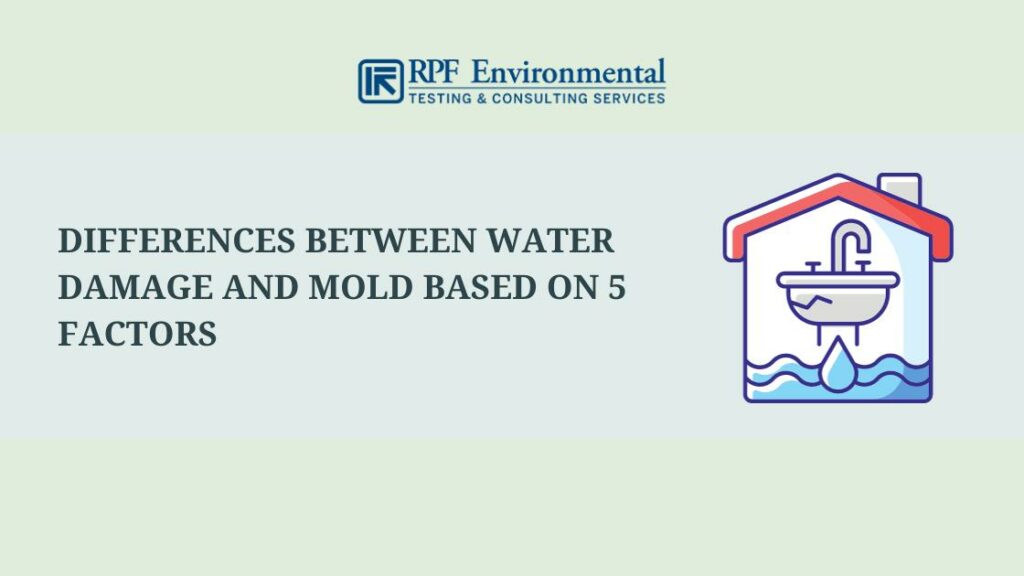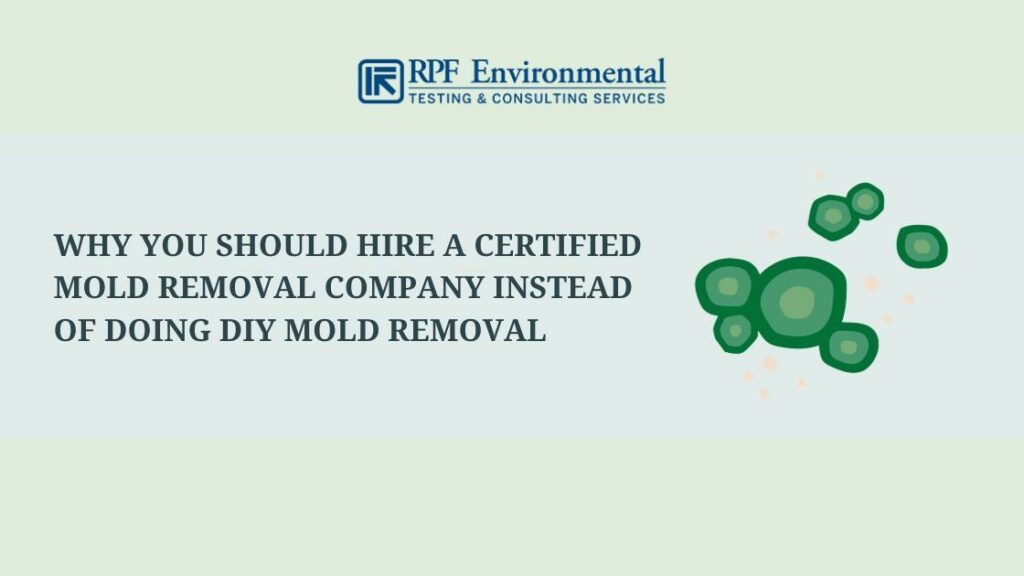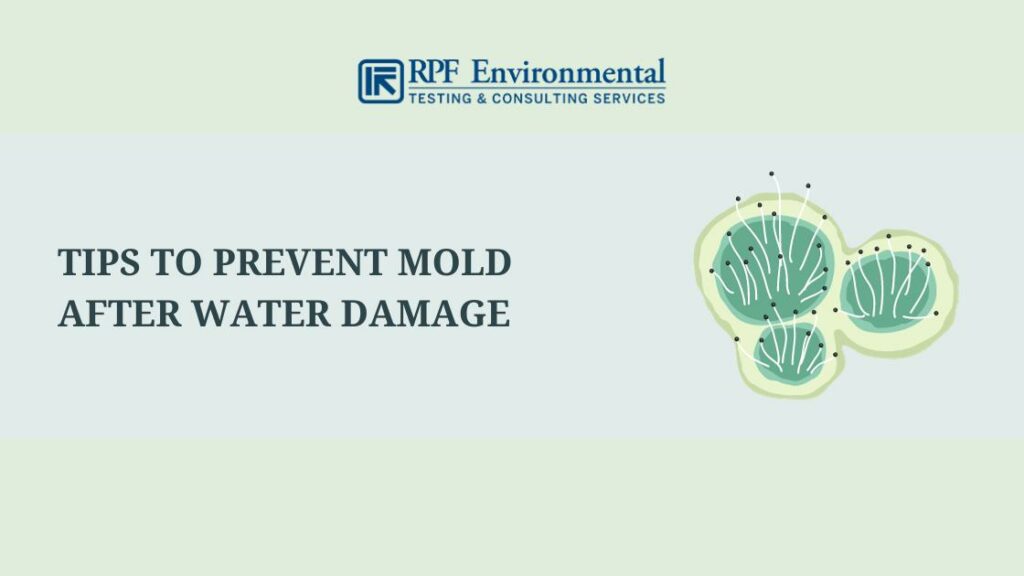Are you seeing stains and discolorations in your ceiling, walls, and other surfaces in your home or building and want to know if you should be concerned about mold growth?
Water and mold damage are both big problems that you need to address immediately to prevent further damage to your property. Water damage causes mold to grow and does not spread throughout your home. Airborne mold spores, on the other hand, can travel to other areas of your home and grow once they land on damp surfaces. Continue reading to learn more about how to differentiate between mold and water damage.
Key Takeaways
- Physical appearance alone is not enough to differentiate water damage from mold. A musty, pungent, or earthy smell is a more definite sign of mold growth.
- Water damage does not always mean mold, but signs of water damage may indicate mold growth since mold grows where there is a lot of moisture.
- Clean and dry water-damaged surfaces within 24-48 hours to prevent mold growth.
- You need to have mold professionally removed and fix sources of moisture. Otherwise, it will continue spreading and lead to significant damage and costly repairs.

RPF Environmental has certified mold testing and remediation professionals to help you make sure that all sources of mold growth including water damage are identified and fixed. Contact us now for affordable services in Illinois, Indiana, Massachusetts, New Hampshire, Maine, and throughout the country.
Differences Between Water Damage and Mold Based on 5 Factors

Water damage is caused by excessive water exposure (e.g. floods, leaks, and burst pipes) while mold can be caused by water damage.
Discolorations caused by water damage often look consistent while mold growth has irregular stains, but physical appearance is not enough to differentiate mold from water damage. One of the most definite signs of mold growth is smelling something musty or pungent.
#1. Physical Appearance
Water stains may indicate the possibility of mold growing in your home/building because mold grows where there is a lot of moisture. Thus, you will most likely find mold on water-damaged surfaces.
| Water Damage | Mold |
|---|---|
| – Lighter stains in brown, orange, or yellow – Looks like water droplets or pooled water – Bubbling, flaking, or peeling paint on your wallpaper and/or wall – Buckling or warped wooden flooringBubbling or curling vinyl flooring | – Darker discolorations in black, gray, green, or blue – Fuzzy, powdery, slimy, and/or damp – Smudges when touched |
You will see visible signs of water damage in a shorter time compared to mold which can take a few weeks before you notice any signs. But, there are times when you will only spot leaks once mold has already started growing.
Also, visible discolorations on surfaces such as your ceiling and walls are among the first signs of mold problems. However, take note that mold comes in various types of mold species with Aspergillus, Cladosporium, and Penicillium being the most common household mold types. Thus, they can come in other colors aside from the ones mentioned above.
Also Read: Mold Testing & Detection Tips: How to Test for Mold in Your Air, Walls, or Basement Effectively
#2. Smell
Water damage rarely has a smell, especially if you have already fixed the problem and dried the affected areas. On the other hand, mold from water damage often smells musty, earthy, rotten, or pungent. By this time, the air you’re inhaling indoors may have already been filled with airborne mold spores.
#3. Dangers
Damage caused by water leaks, previous flooding, and other causes can compromise your building or home’s structural integrity. It can cause your walls to warp and your ceiling might collapse due to roof leaks. However, damage will often happen in areas affected by water.
On the contrary, mold due to water damage and leaks will grow on any damp surface where airborne spores have landed on. It is commonly found in moisture-prone areas such as your basement, crawl spaces, bathroom, and laundry room including your walls, flooring, carpets, furniture, and others. It often grows on organic materials including wood, paper, drywall, and insulation that provides the nutrients it needs.
In addition, mold infestation will get worse if left untreated and cause significant damage to your home’s structure.
Also Read: 17 Common Places Where You Can Find Mold in Your Home
Mold From Water Damage Health Risks
While water damage rarely causes health complications, the problems it causes, including mold infestation, are more serious and can cause severe health problems. According to the EPA, mold produces irritants and allergens that cause sneezing, red eyes, skin rash, sore throat, and runny nose when touched or inhaled. Sensitive individuals can experience asthma attacks. It can even cause lung infections.
#4. Repair & Removal
Minor water damages are easy to fix after drying out the affected surfaces and fixing the source of the problem. But for mold, its roots can spread deep into porous materials and can be difficult to remove. Nonetheless, both severely damaged porous materials due to water infiltration and mold infestation may need to be disposed of.
Mold Cleanup & Removal Tips
“If the moldy area is less than about 10 square feet (less than roughly a 3 ft. by 3 ft. patch), in most cases, you can handle the job yourself.”
– Mold Cleanup in Your Home
Below are some tips you can follow to safely remove mold due to water leaks, floods, and other causes:
- You can clean small mold infestations, but always contact a certified mold remediation company if the water damage is severe and the mold growth is more than 10 square feet.
- Better hire a mold testing company to ensure that all sources of water damage and mold, including hidden mold, are dealt with in your home.
- Consult your physician if you are experiencing symptoms of mold poisoning before doing DIY mold removal.
- Clean mold on hard surfaces using water and detergent and dry them completely.
- Wear protective gear (N-95 respirator, goggles, and long gloves) before cleaning.
Also Read: Mold Remediation Using Bleach: When to Use It, Why Not Use It, & Safer Alternatives
#5. Repair & Removal Costs
Water damage restoration costs range from $1,300 to $5,900+ but can be as low as $450 and as high as $15,000+. Factors affecting the cost include:
- The type of water (clean, gray, or black water)
- Cause of the water damage (leaks, extensive flood damage, etc.)
- The extent of the damage
- The type of damaged materials (roof, hardwood, floors, drywall, ceiling, basement, etc.)
- Your location
Mold remediation costs usually range from $1,500 to $5,000+ but can be as high as $10,000+ depending on:
- Location of the mold (HVAC systems, attics, and drywall may cause higher)
- Square footage of the affected area
- Type of mold
- Accessibility of the affected area
- Your location
In addition, we highly recommend conducting mold testing after mold remediation to ensure that no mold is left in your home/building. This will cost you an additional $300 to $1,000+.
How Can You Tell if You Have Mold Damage? Does Water Damage Mean Mold Growth?
Moisture is the main cause of mold growth. This means that if you see signs of water damage, mold will most likely grow or is already growing. However, water damage does not always cause mold growth if you have dried and fix the affected materials within 24 to 48 hours.
Also Read: Roof Leaks, Ceiling Water Damage, & Mold Growth: Causes, Signs, & Removal
Why You Should Hire a Certified Mold Removal Company Instead of Doing DIY Mold Removal

Mold remediation professionals are certified, trained, experienced, and have the right tools to effectively, safely, and completely remove mold in your home/building.
Why DIY Mold Removal Is Dangerous
Attempting to remove mold on your own without experience and appropriate tools will cause mold spores to become airborne. Thus, exposing yourself and your family to toxic mold. In addition, untrained individuals cannot identify hidden mold and you might not be able to get rid of mold completely in your property.
What Professional Mold Remediation Companies Do
The tasks of professional mold remediation companies include the following:
- Wear proper protective clothing.
- Inspect the area to determine the appropriate tools, equipment, and removal method to be used.
- Identify and repair sources of mold growth.
- Contain the affected area before mold removal.
- Remove damaged materials like drywall, carpeting, furniture, and others.
- Place removed items in air-tight, thick plastic bags.
- Spray the area with a biocide to kill mold.
- Clean nonporous surfaces.
- Use HEPA vacuums and filters to remove mold spores and purify the air.
- Dry the area using dehumidifiers.
- Dispose of moldy materials in approved landfills.
Tips to Prevent Mold After Water Damage

The first step is to fix sources of water damage in your home to prevent mold growth:
- Plumbing leaks caused by broken connectors, weak joints, extreme temperatures and water pressures, etc.
- Clogged roof gutters
- Burst pipes
- Malfunctioning or aging water appliances
“It is important to dry water-damaged areas and items within 24-48 hours to prevent mold growth.”
– A Brief Guide to Mold, Moisture and Your Home
Below are additional mold prevention and control tips from the EPA:
- Dry wet and damp materials quickly.
- Repair and clean your gutters regularly.
- Keep humidity indoors low.
- Vent moisture-producing appliances outside.
- Use de-humifiers and/or air conditioners.
- Open windows and use exhaust fans when showering, cooking, dishwashing, etc.
- Insulate cold surfaces
FAQs
Water damage usually looks like pooled water in yellow, orange, or brown stains while mold comes in darker shades like black, green, blue, or grey. In addition, water damage causes bubbling, buckling, warping, or peeling of surfaces. Mold appears fuzzy and slimy and smudges when touched.
It is hard to differentiate water damage from mold based on physical appearance alone, but signs of water damage may indicate mold growth. Smelling something musty or pungent is often the first sign of mold infestation.
Water damage does not always mean mold because this will depend on how severe the water damage is and how quickly you have dried and fixed the problem. Drying the affected area within 24 to 48 hours is less likely to cause mold growth.
Conclusion
Water damage does not necessarily mean mold is growing in your home. If you want to prevent mold growth, fixing leaks and other sources of water problems and drying the affected areas quickly is the best solution.
Let RPF Environmental help you fix mold problems due to water damage by identifying the root causes of the problem and finding hidden mold. Get rid of mold in your home completely through our professional mold testing services in the New England region. Contact us now!




